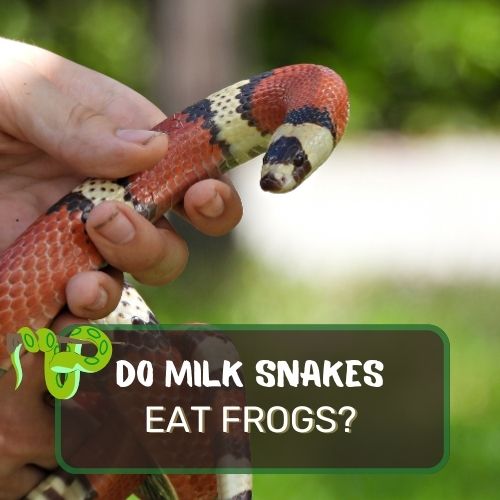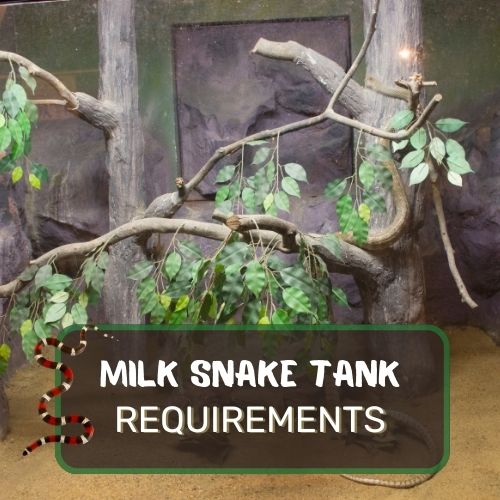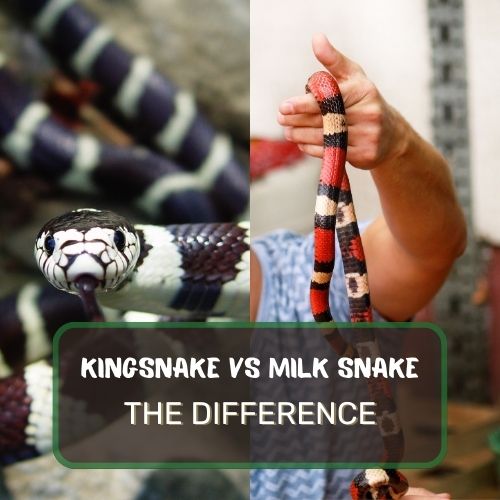Have you ever gazed at a milk snake and wondered what’s going on in its slithering world, especially during those chilly months?
Well, you’re in for a treat! Dive into the mesmerizing realm of brumation—the reptilian version of hibernation—and unravel the mysteries behind this fascinating behavior.
Yes, milk snakes do brumate. Brumation is a period of reduced activity in reptiles, similar to hibernation in mammals. During colder months, milk snakes become less active, eat less, and seek cooler areas in their habitat, preparing for this dormant period.
From understanding what triggers it to ensuring your snake’s well-being, this comprehensive guide delves into every aspect of the milk snake’s winter downtime. Let’s embark on this scaly adventure and decode the secrets of brumation!

Table of Contents
Brumation Explained: Not Just Cold Snakes!
Have you found yourself pondering, “what is the difference between brumation and hibernation?” Well, you’re about to get all those burning questions answered.
The Difference Between Brumation and Hibernation
Picture this: a bear, snuggled up in its den, snoozing away the winter. That’s hibernation. Now, think of our slithering friend, the milk snake, in a cool spot, motionless but not exactly deep in dreamland.
That, my friend, is brumation.
While both hibernation and brumation can be considered nature’s snooze buttons for animals, they’re not the same. Hibernation is mainly for warm-blooded animals like bears and bats. Their body temperatures drop, and they enter a deep sleep.
On the other hand, our cold-blooded comrades like the milk snake experience brumation. Their metabolism slows way down, but they remain somewhat alert. You won’t catch them counting sheep, but they aren’t completely out of it either.
Why Reptiles Like Snakes Brumate
Reptiles have a fascinating way of dealing with harsh conditions. As cold-blooded animals, their body temperature is regulated by their surroundings.
So, when Jack Frost comes knocking, milk snakes, among other reptiles, don’t crank up the heat. Instead, they enter brumation. This slows down their bodily functions, reduces their need for food, and allows them to survive the colder months without much fuss.
It’s like they’re saying, “Winter? No problem. I’ll just chill—literally.”
How It’s Different from Mere Sleeping
Let’s dive a little deeper. Most animals sleep, right? But brumation is an entirely different ball game. Think of it as a super long, super chill power nap.
Unlike their nightly slumbers, where they recharge and then are back to their energetic selves, during brumation, snakes like the milk snake go into a months-long state of reduced activity. They might move occasionally, perhaps to drink some water, but they won’t eat.
It’s almost as if they’re in standby mode, conserving energy, waiting for the world to warm up again.
In a nutshell, when milk snakes brumate, it’s not just an extended nap or a reaction to a binge-watched series. It’s an instinctual, survival-driven response, honed over millennia, ensuring they see another sunny day.
So the next time you’re out and about and spot a still snake on a chilly day, you’ll know—nature’s just hit the pause button.

The Signs: How to Tell if Your Milk Snake is Brumating
So, you’ve got a milk snake. Perhaps it’s become less active, or you’ve noticed it’s not as hungry as usual. Are they just being lazy? Have they embarked on a spontaneous diet? Or are they, in fact, brumating? Let’s decipher this reptilian riddle!
Changes in Behavior
First up, behavior. Milk snakes, when gearing up for brumation, undergo a shift in their daily routine. Remember that friend who suddenly became a homebody because they discovered a new TV series?
Well, it’s somewhat like that. These snakes become less active, often staying in one spot for extended periods.
Decreased Appetite
Next on the list: food. Or rather, the lack of interest in it. As the temperature drops, so does their metabolism. So, that juicy mouse or the delicious worm doesn’t seem all that appetizing anymore.
It’s like their version of skipping dessert—a telltale sign that brumation might be on the horizon.
Seeking Cooler Areas in Their Habitat
If you find your milk snake snuggling up in the cooler part of its terrarium, it’s not trying to escape your love; it’s just looking for the perfect brumation spot.
Much like we might pull on a sweater when chilly, they seek out cooler areas to kickstart their brumation process.
How Long It Usually Lasts
And now, the million-dollar question: How long? Brumation can last anywhere from a few weeks to several months. Think of it as a winter retreat, but instead of sun and sand, it’s all about cool vibes—literally.

Creating the Perfect Brumation Environment
Alright, so your snake’s decided to take a winter sabbatical. How do you ensure it’s comfortable, safe, and ready to bounce back when spring arrives?
Ensuring the Snake is Healthy
Before even thinking about brumation, we’ve got to play doctor. It’s crucial to ensure that your milk snake is in prime health. Any lingering health issues might get exacerbated during brumation.
A quick check-up or consultation with a vet can provide the green light.
Diet Adjustments Before Brumation
Prep time! In the weeks leading up to brumation, reduce their food intake gradually. This ensures they don’t have undigested food in their system, which could lead to complications during their downtime.
Think of it as getting them into the “brumation mindset.”
Tips for Setting Temperature and Humidity
The ambiance is key! Ensure the cool end of their habitat hovers between 55°F and 70°F. Use a reliable thermostat for accuracy. As for humidity, maintain a range that mimics their natural environment, generally around 50% for milk snakes.
This isn’t a spa, but let’s make it as cozy as possible.
Monitoring Your Snake During This Period
Lastly, even though they’re in low-power mode, keep a close eye on them. Regular, gentle check-ins ensure they’re doing alright. Ensure they have access to water, and remember: no feeding during brumation.
Whether your milk snake is taking its annual chill pill or you’re prepping for its winter downtime, you’re now equipped with all the know-how. Cheers to happy, healthy brumating!

Post-Brumation Care: Waking up on the Right Side of the Terrarium
Imagine hitting the snooze button for months on end, and suddenly, the alarm blares! That’s sort of what coming out of brumation feels like for your milk snake. It’s crucial we ease them back into their daily grind—snake style.
Gently Reintroducing Them to Warmer Temperatures
First things first: warmth. Slowly increase the temperature in their habitat over several days. Avoid sudden temperature spikes. Think of it as a gentle morning stretch after a long night’s sleep.
Feeding After Brumation
When it comes to food, patience is key. Offer a small meal a few days after they show signs of increased activity. Their metabolism is still revving up, so don’t be surprised if they aren’t immediately interested.
But trust me, once that engine’s running, they’ll be ready to chow down!
Signs They’re Coming Out of Brumation Successfully
Keep an eye out for increased movement, a rekindled interest in food, and them exploring their terrarium. It’s like they’re rediscovering their world, and it’s your first sign that brumation is wrapping up.

Brumation vs. Illness: How to Tell the Difference
It’s a common conundrum: Is my milk snake brumating, or is something amiss? Here’s how to differentiate between a natural, healthy brumation and potential illness.
Typical Behaviors of a Sick Milk Snake
A sick snake might show lethargy, but there are other signs. Look for skin discoloration, mucus around the mouth or nose, and any unusual lumps or bumps. If their skin isn’t smoothly shedding or they seem persistently disoriented, take note.
Key Differences Between a Brumating and an Ill Snake
While both brumating and sick snakes may seek cooler spots, a brumating snake will still seem alert when disturbed. In contrast, a sick snake may appear listless or unresponsive.
Also, remember: brumation is seasonal, so if these behaviors pop up in, let’s say, the heat of summer, it might be a cause for concern.
When to Seek Veterinary Care
If you’re ever in doubt, it’s better to be safe than sorry. If your snake shows prolonged signs of distress, abnormal behaviors outside of the brumation season, or doesn’t bounce back after their winter downtime, it’s time to consult a vet.
After all, a little expert advice can go a long way in ensuring your slithery sidekick stays in tip-top shape!
Wrapping It Up
You’ve journeyed through the captivating world of milk snakes and their brumation habits. By now, you understand that this natural dormancy, much like hibernation in mammals, is essential for their well-being during colder months.
Recognizing the signs and ensuring proper care can make all the difference for your slithery friend. Keep observing, keep learning, and remember: equipped with this knowledge, you’re now perfectly poised to support your milk snake through its seasonal retreat.
Embrace every moment of this incredible journey with your reptilian companion!
FAQ
Ah, the burning questions! Let’s break down some of the most frequently asked queries about milk snakes and their fascinating brumation behavior.
Do Snakes Eat During Brumation?
Nope! During brumation, a snake’s metabolism drops significantly. This means they don’t feel the need to eat. In fact, feeding a brumating snake can be harmful since they won’t digest the food properly. It’s their way of saying, “I’m on a break!”
Do Milk Snakes Bask?
You bet they do! Even though they’re chilling out during brumation, milk snakes, like other reptiles, will occasionally come out to bask. It’s their way of getting a bit of warmth and maintaining their body functions.
How Do You Know if a Snake is in Brumation?
Look for signs like reduced activity, a decreased appetite, and seeking cooler spots in their habitat. Also, remember that brumation typically occurs during colder months, aligning with the change in seasons.
What Triggers Brumation?
Mother Nature’s cues! As daylight decreases and temperatures drop, snakes sense these environmental changes, and it signals their bodies to begin the brumation process. It’s like their internal calendar saying, “Winter’s coming. Time to chill!”




0 Comments